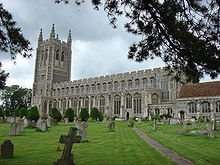羊毛教堂
羊毛教堂(wool church)是指建造資金主要來自因中世紀羊毛貿易致富,希望他們的慷慨能確保自己在天堂有一個位置的商人和農民捐款的英格蘭教堂[1]。

羊毛教堂在科茨沃爾德和東盎格利亞的「羊毛城鎮」中很常見,在那些地方,羊毛業務的巨大利潤刺激了建造更宏偉的建築。羊毛教堂的建造往往是為了取代一個較小或不那麼宏偉的禮拜場所,以反映它所處社區日益繁榮。許多這樣的建築項目是由每個村莊或城鎮的少數家庭投資的,他們利用新的教堂建築來展示自己的財富、地位和信仰。羊毛教堂的建設大致結束於英格蘭宗教改革,以及同期在1525年至1600年羊毛貿易的下降。
著名的羊毛教堂
編輯朗梅爾福德
編輯薩福克郡朗梅爾福德的朗梅爾福德聖三一堂被廣泛認為是東盎格利亞最好的羊毛教堂之一。該堂主要建於1467-1497年,由當地布商,[2] 主要是約翰·克洛普頓資助,擁有絢麗的十五世紀花窗玻璃, 克洛普頓家族小堂和東端高聳的聖母小堂。[3]聖三一堂的浮雕(Flushwork)是英格蘭最好的。該堂見證了在中世紀羊毛生意令人眼花繚亂的成功。[4]。
索思沃爾德
編輯另一個宏偉的薩福克郡教堂是索思沃爾德的聖愛德門堂(St Edmund's Church,),保留了中世紀的聖壇屏飾[5]。
考斯頓
編輯諾福克郡考斯頓的聖亞革尼斯堂(St. Agnes' Church)也被稱為「羊毛教堂」。其十五世紀的中殿和西側鐘樓由薩福克伯爵麥可·德拉波爾資助。他通過羊毛生意致富。[6]作為典型的「羊毛教堂」,聖亞革尼斯堂的規模遠比普通的中世紀村莊所需要的要宏偉得多。薩福克伯爵不遺餘力地美化內部:入口上方的雕刻;法國石料用於鐘樓和中殿;屋頂雖然還是典型的木製東盎格利亞風格,但是精心設計了彎曲的梁,三位天使伸出翅膀盤旋[7]。
顯然,在中世紀的東盎格利亞,綿羊為建築贖罪提供了貨幣。
伊普斯威奇聖革利免堂
編輯伊普斯威奇聖革利免堂的資金主要來自伊普斯威奇港口的羊毛貿易。鐘樓,是由富有的羊毛商人捐款建造的。[8]
參考
編輯- ^ A Look at Some of the Historic Textile Hot Spots in the UK. Stuart Morris. Stuart Morris Co. UK. 2016.
Sheep farmers became incredibly rich exporting the 『golden fleece’ and, with religious orders owning many flocks, much of the money went into building churches. Rich merchants also wanted to ensure their safe passage to paradise and so would donate portions of their profits towards building these 『wool churches』.
- ^ Long Melford, Holy Trinity Church. Britain Express. Britain Express. [April 25, 2016]. (原始內容存檔於2020-11-24).
This Grade I listed church was built almost completely during the 15th century, at a time of great prosperity for local cloth merchants.
- ^ Holy Trinity Church, Long Melford, Suffolk, suffolkchurches.co.uk. [2020-11-27]. (原始內容存檔於2021-01-02).
- ^ web site of Holy Trinity, Church, Long Melford, Suffolk. [2020-11-27]. (原始內容存檔於2014-05-17).
- ^ St. Edmund, Southwold, photos, suffolkchurches.co.uk. [2020-11-27]. (原始內容存檔於2021-01-09).
- ^ St. Agnes' Church at Cawston. Cawston Parish at Norfolk - UK. Cawston Parish at Norfolk - UK. 2016 [April 25, 2016]. (原始內容存檔於2016-05-08).
a wool church being financed and built by Michael de la Pole, 2nd Earl of Suffolk and Catherine his wife (with the exception of the north aisle built by Robert Oxburgh) displaying wealth which he gained from the woollen Industry
- ^ World History of Architecture, Marian Moffett, Michael Fazio, Lawrence Wodehouse, McGraw-Hill Professional, New York, 2003
- ^ Ipswich Icons: Can a new use be found for abandoned medieval church?. Ipswich Star (30 June 2018) (Archant Community Media Ltd). 2018 [2020-11-27]. (原始內容存檔於2020-02-20) (英語).